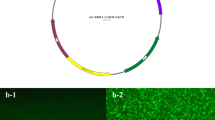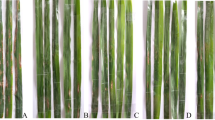Abstract
The development of the olive knot disease, caused by Pseudomonas savastanoi pv. savastanoi was studied taking into consideration the anatomical changes at the inoculation sites. The genesis of knots was investigated in the absence and presence of Pseudomonas fluorescens bv. PICF4, a natural colonizer of olive roots and an effective biocontrol agent (BCA) of verticillium wilt of olive. This bacterium was investigated for its potential as a BCA against olive knot disease. Bioassays using 5-month-old olive plants (cv. Arbequina) were performed to assess the interaction between olive plant stems, Pseudomonas savastanoi KT11, isolated from active knots of naturally infected olive twigs, and PICF4. Thus, we studied whether strain PICF4 controlled knot development and anatomy compared with those observed in the absence of PICF4, and the population size of both bacteria when co-inoculated together in stems or separately injected at different intervals after inoculation. Results revealed that PICF4 was able to settle, colonize and persist in stem tissues upon artificial inoculation. While PICF4 was unable to suppress disease development, its presence affected the pathogen population size (reduction of ≈ 25% at 54 days post inoculation) and produced smaller knots. Histological sections (± 40 μm thicknesses) cut with a vibrotome and observed under a light microscope showed less tissue alterations and less cavities inside the knots, compared with those produced when the pathogen was inoculated without PICF4.










Similar content being viewed by others
References
Ganeshan G, Manoj Kumar A (2005) Pseudomonas fluorescens, a potential bacterial antagonist to control plant diseases. J Plant Interact 1(3):123–134. https://doi.org/10.1080/17429140600907043
Gardan L, Bollet C, Abu Ghorrah M, Grimont F, Grimont PAD (1992) DNA relatedness among the pathovar strains of Pseudomonas syringae subsp. savastanoi Janse (1982) and proposal of Pseudomonas savastanoi sp. nov. Int J Syst Bacteriol 42:606–612
Gordon SA, Weber RP (1951) Colorimetric estimation of indoleacetic acid. Plant Physiol 26:192–195
Janse JD (1982) The bacterial disease of ash (Fraxinus excelsior) caused by Pseudomonas savastanoi pv. fraxini. III. Pathogenesis. Eur J For Pathol 12:218–231
Kacem M, Kazouz F, Merabet C, Rezki M, De Lajudie P, Bekki A (2009) Antimicrobial activity of Rhizobium sp. strains against Pseudomonas savastanoi, the agent responsible for the olive knot disease in Algeria. Grasas Aceites 60:139–146
King EO, Ward MK, Raney DE (1954) Two simple media for the demonstration of pyocyanin and fluorescin. J Lab Clin Med 44:301–307
Krid S, Triki MA, Gargouri A, Rhouma A (2011) Biocontrol of olive knot disease by Bacillus subtilis isolated from olive leaves. Ann Microbiol. https://doi.org/10.1007/s13213-011-0239-0
Lavermicocca PS, Lonigro L, Valerio F, Evidente A, Visconti A (2002) Reduction of olive knot disease by a Bacteriocin from Pseudomonas syringae pv. ciccaronei. Appl Environ Microbiol 68:1403–1407
Lelliot RA, Stead DE (1987) Methods for the diagnosis of bacterial diseases of plants. Blackwell Scientific, Oxford
MacFaddin J (1985) Media for Isolation-Cultivation-Identification-Maintainance of medical Bacteria, Vol. l, Williams. Wilkins, Baltimore
Maldonado-González MM, Prieto P, Ramos C, Mercado-Blanco J (2013) From the root to the stem: interaction between the biocontrol root endophyte Pseudomonas fluorescens PICF7 and the pathogen Pseudomonas savastanoi NCPPB 3335 in olive knots. Microb Biotechnol 6:275–287
Mercado-Blanco J, Rodríguez-Jurado D, Hervás A, Jiménez-Díaz RM (2004) Supression of verticillium wilt in olive planting stocks by root-associated fluorescent Pseudomonas spp. Biol Control 30:474–486
Penyalver R, García A, Ferrer A, Bertolini E, Quesada JM, Salcedo CI (2006) Factors affecting Pseudomonas savastanoi pv. savastanoi plant inoculations and their use for evaluation of olive cultivar susceptibility. Phytopathology 96:313–319
Prieto P, Navarro-Raya C, Valverde-Corredor A, Amyotte SG, Dobinson KF, Mercado-Blanco J (2009) Colonization process of olive tissues by Verticillium dahliae and its in planta interaction with the biocontrol root endophyte Pseudomonas fluorescens PICF7. Microb Biotechnol 2:499–511
Quesada JM, Penyalver R, Pérez-Panadés J, Salcedo CI, Carbonell EA, López MM (2010a) Dissemination of Pseudomonas savastanoi pv. savastanoi populations and subsequent appearance of olive knot disease. Plant Pathol 59:262–269
Quesada JM, Penyalver R, Pérez-Panadés J, Salcedo CI, Carbonell EA, López MM (2010b) Comparison of chemical treatments for reducing epiphytic Pseudomonas savastanoi pv. savastanoi populations and for improving subsequent control of olive knot disease. Crop Prot 29:1413–1420
Ramos C, Matas IM, Bardaji L, Aragón IM, Murillo J (2012) Pseudomonas savastanoi pv. savastanoi: some like it knot. Mol Plant Pathol 13:998–1009
Rokni Z, Khavazi K, Asgharzadeh AM, De Mot HR (2008) Biocontrol of Pseudomonas savastanoi pv. savastanoi, causative agent of olive knot disease: antagonistic potential of nonpathogenic rhizosphere isolates of fluorescent Pseudomonas. Commun Agric Appl Biol Sci 73:199–203
Ruzin SE (1999) Plant microtechnique and microscopy. Oxford University Press, Oxford
Saad AT, Hanna L (2002) Two new hosts of Pseudomonas savastanoi and variability in strains isolated from different hosts. Phytopathology 9
Salaheddin K, Valluvaparidasan V, Ladhalakshmi D, Velazhanan R (2010) Management of Bacterial Blight of cotton using a mixture of Pseudomonas fluorescens and Bacillus subtilis. Plant Protect Sci 46:41–50
Sisto A, Morea M, Zaccaro F, Palumbo G, Iacobellis NS (1999) Isolation and characterization of Pseudomonas syringae susp. savastanoi mutants defective in hypersensitive response elicitation and pathogenicity. J Phytopathol 147:321–330
Smith EF (1920) An introduction to bacterial diseases of plants. W.B. In: Saunders Co. USA, Philadelphia, PA
Surico G (1977) Histological observations on olive knots. Phytopathol Mediterr 16:109–125
Temsah M, Hanna L, Saad AT (2007a) Anatomical observations of Pseudomonas savastanoi on Rhamnus alaternus. For Pathol 37:1–13
Temsah M, Hanna L, Saad AT (2007b) Histological pathogenesis of Pseudomonas savastanoi on Myrtus communis. J Plant Pathol 89:241–249
Temsah M, Hanna L, Saad AT (2008a) Histological pathogenesis of Pseudomonas savastanoi on Nerium oleander. J Plant Pathol 90:407–413
Temsah M, Hanna L, Saad AT (2008b) Anatomical pathogenesis of Pseudomonas savastanoi on olive and genesis of knots. J Plant Pathol 92:225–232
Temsah M, Hanna L, Saad AT (2010). Histological pathogenesis of Pseudomonas savastanoi on Nerium oleander. J. Plant Pathol. 92:407–413
Teviotdale BL, Krueger WH (2004) Effects of timing of copper sprays, defoliation, rainfall, and inoculum concentration on incidence of olive knot disease. Plant Dis 88:131–135
Thind BS (2015) Diagnosis and Management of Bacterial Plant Diseases. In: Recent Advances in the Diagnosis and Management of Plant Diseases, pp 101–117
Wilson EE (1965) Pathological histogenesis in oleander tumors induced by Pseudomonas savastanoi. Phytopathology 55:1244–1249
Young JM (2004) Olive knot and its pathogens. Australas Plant Pathol 33:33–39
Author information
Authors and Affiliations
Corresponding author
Ethics declarations
Conflict of interest
The authors declare that they have no conflict of interest.
Statement of human and animal rights
This article does not contain any studies with human or animal subjects performed by the any of the authors.
Additional information
Publisher’s note
Springer Nature remains neutral with regard to jurisdictional claims in published maps and institutional affiliations.
Rights and permissions
About this article
Cite this article
Ghanney, N., Ferchichi, A. Anatomical pathogenesis and histological interaction between Pseudomonas savastanoi pv. savastanoi strain KT11 and Pseudomonas fluorescens strain PICF4 in olive knots. J Plant Pathol 101, 1025–1034 (2019). https://doi.org/10.1007/s42161-019-00333-3
Received:
Accepted:
Published:
Issue Date:
DOI: https://doi.org/10.1007/s42161-019-00333-3




